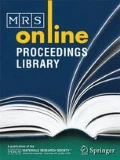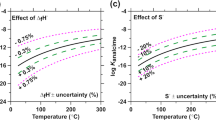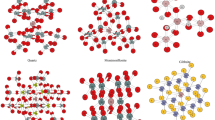Abstract
A set of computer programs has been developed to draw chemical-equilibrium diagrams. This new software is the Java-language equivalent to the Medusa/Hydra software (developed some time ago in Visual basic at the Royal Institute of Technology, Stockholm, Sweden). The main program, now named “Spana” calls Java programs based on the HaltaFall algorithm. The equilibrium constants that are needed for the calculations may be retrieved from a database included in the software package (“Database” program). This new software is intended for undergraduate students as well as researchers and professionals.
The “Spana” code can be easily applied to perform radionuclide speciation and solubility calculations of minerals, including solubility calculations relevant for the performance assessment of a nuclear waste repository. In order to handle ionic strength corrections in such calculations several approaches can be applied. The “Spana” code is able to perform calculations based on three models: the Davies equation; an approximation to the model by Helgeson et al. (HKF); and the Specific Ion-Interaction Theory (SIT). Default SIT-coefficients may be used, which widens the applicability of SIT significantly.
A comparison is made here among the different ionic strength approaches used by “Spana” (Davies, HKF, SIT) when modelling the chemistry of radionuclides and minerals of interest under the conditions of a geological repository for nuclear waste. For this purpose, amorphous hydrous Thorium(IV) oxide (ThO2(am)), Gypsum (CaSO4·2H2O) and Portlandite (Ca(OH)2) solubility at high ionic strengths have been modelled and compared to experimental data from the literature. Results show a good fitting between the calculated values and the experimental data especially for the SIT approach in a wide range of ionic strengths (0–4 M).
Similar content being viewed by others
References
G Azimi. (2010). Evaluating the Potential of Scaling due to Calcium Compounds in Hydrometallurgical Processes. PhD Thesis, University of Toronto.
C. Christov and N Moller. (2004). Geochim. Cosmochim. Acta 68, 3717–3739.
C.W Davies. (1962). Ion association. London, Butterworths.
R. Ekelund, L. G. Sillén and O Wahlberg. (1970). Acta Chem. Scand. 24, 3073. 10.3891/acta.chem.scand.24-3073
G Eriksson. (1979). Anal. Chim. Acta 112, 375–383.
A.R. Felmy, D. Rai and M.J Mason. (1991). Radiochim. Acta 55, 177–185. 10.1524/ract.1991.55.4.177
I. Grenthe, A. V. Plyasunov and K Spahiu. (1997) In Modelling in Aquatic Chemistry (eds. I. Grenthe and I. Puigdomenech), pp. 325–426. OECD Nuclear Energy Agency, Paris, France.
H. C. Helgeson, D. H. Kirkham and D. C Flowers. (1981). Am. J. Sci. 281, 1249–1516. 10.2475/ajs.281.10.1249
W Hummel. (2009) Report PSI-TM-44-09-01, Paul Scherrer Institut.
N. Ingri, W. Kakolowicz, L. G. Sillén and B Warnqvist. (1967) Talanta 14, 1261–1286. Errata: 15(3) (1968) xi-xii. 10.1016/0039-9140(67)80203-0
D. K Nordstrom., (2005). In Surface and Ground Water, Weathering, and Solids (ed. J.I. Drever), pp. 37–72. Amsterdam, The Netherlands: Elsevier.
I Puigdomenech. (1983) Report TRITA-OOK-3010, Dept. Inorg. Chem., Royal Institute of Technology, 100 44 Stockholm, Sweden.
I Puigdomenech. (2000) In “219th ACS National Meeting. San Francisco, CA, March 26-30, 2000. Abstracts of Papers”, Vol. 1, abstract I&EC-248. American Chemical Society.
D.L. Parkhurst and C.A.J Appelo. (2013). U.S. Geological Survey Techniques and Methods, Book 6, Chap. A43.
M. Rand, J. Fuger, I. Grenthe, V. Neck, D Rai. (2009) Chemical Thermodynamics of Thorium. OECD Nuclear Energy Agency, Paris, France.
B. Warnqvist and N Ingri. (1971) Talanta 18, 457–458.
Author information
Authors and Affiliations
Rights and permissions
About this article
Cite this article
Puigdomènech, I., Colàs, E., Grivé, M. et al. A tool to draw chemical equilibrium diagrams using SIT: Applications to geochemical systems and radionuclide solubility. MRS Online Proceedings Library 1665, 111–116 (2014). https://doi.org/10.1557/opl.2014.635
Published:
Issue Date:
DOI: https://doi.org/10.1557/opl.2014.635




